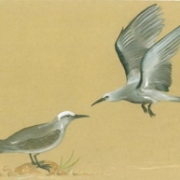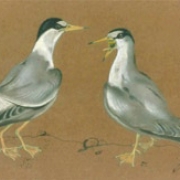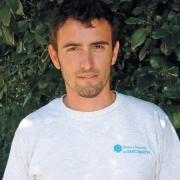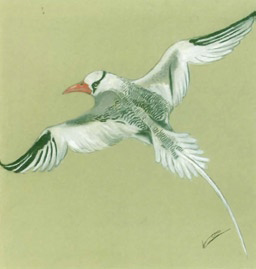As for the marine bird population, both small and large White-tailed Tropicbirds nest in crevices along Rocher Créole, Tintamare, and Caye Verte: 8 to 9 individual birds were seen on each outing and 36 nests have been counted at the three sites, representing a slight regression since 2009.
The interdiction to anchor in North Cove has proved very positive for the Brown Noddy that nests on Tintamare from March through May, and last season there were 69 different specimens observed and 30 nests.
The Little Tern, which nests in the sand, abandons its nest as soon as it is disturbed, perhaps by a dog, a pedestrian, or worse, a quad. Heavy rains that might flood their nests, or make it difficult to nest in the sandbanks, also endanger these birds. 15 of them could be spotted on each field trip to the Orient Salt Pond and a total of 47 nests were noted at the various sites.
The Roseate Stern was observed for the first time last year near Rocher Créole, Tintamarre, the Pointe du Bluff, and the Orient Salt Pond.
 Noddi Brun - Marie Estelle Voisin
Noddi Brun - Marie Estelle Voisin Petit Sterne - Marie Estelle Voisin
Petit Sterne - Marie Estelle Voisin Camille Bouzon
Camille Bouzon Camille Bouzon, a 24 year-old masters degree student in “tropical ecology and agrosystems engineering” at the UAG in Guadeloupe, is doing an internship with the Réserve Naturelle from January 9 through June 15, 2012.
Originally from Marennes, this passionate ornithologist is learning about Saint Martin’s richness is this field.
Since his arrival, he has been studying the division of birds at the various sites and salt ponds, in order to create a zone chart that refines the ecology of these protected species and which can be used in the installation of improvements to the ponds, as spelled out in a study done about the ponds in 2010 and 2011.
He also did a study on the disturbance of birds at the Orient Salt Pond, where traces of all-terrain vehicles were found right to the water’s edge. As we have noted, these disturbances frighten the birds, which take flight, feed less, abandon their nests and ultimately desert the ecosystems that they depend on. In his study of marine and shore birds, Bouzon’s mission also includes improving the protocol for the study, as much as may be needed.
For example, he has proposed to regroup the same types of bids to optimize the counting procedures: the grouping of “Least Sandpipers” and “Semipalmated Sandpipers” into one group of “Small Sandpipers” would be useful in terms of the study and its statistics. Bouzon is also heading up a discussion related to ecotourism, as amateur ornithologists make up an important group of potential tourists.

















